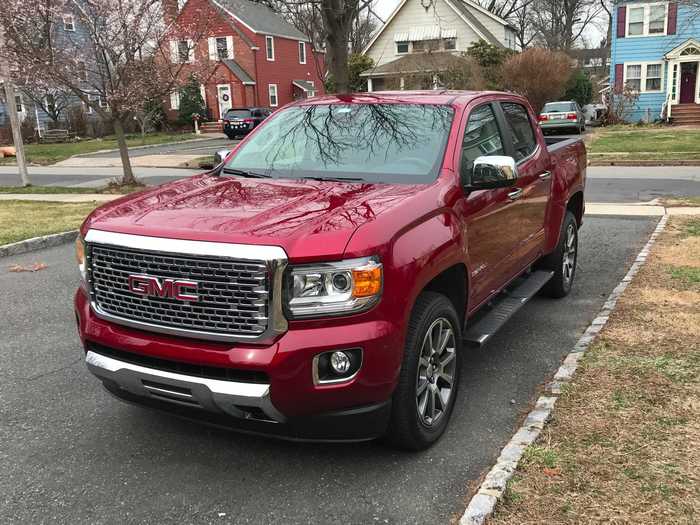I've driven midsize trucks from Ford, Chevy, GMC, Honda, Toyota, and Jeep. And best pickup is clear — although it has plenty of competition
Matthew DeBord

- I've driven midsize pickup trucks from Ford, Chevy, GMC, Honda, and Toyota.
- The midsize pickup truck segment has been robustly revived since 2014, with new models cutting into Toyota's market in the US.
- Consumers have a wide range of choices — especially if they want a midsize pickup that can deliver great offroad performance.
- The Chevy Colorado ZR2 Bison is the best, but it has a challenger in the Jeep Gladiator Rubicon.
- Visit Business Insider's homepage for more stories.
Just a few years ago, the midsize pickup-truck market was all but forgotten. You had precious few choices, and to be honest, if you didn't want to go full-size, you probably ended up with a Toyota Tacoma.
This contrasted vividly with a period in the 1980s when smaller, compact pickups were quite popular and, for many folks, and a good form of basic transportation. My first car was a pickup truck: a Mazda B2200 (cousin to the mechanically similar Ford Ranger). It was barebones: four-cylinder motor, five-speed manual, bench seats, crank windows, AM/FM radio, and no AC. My brother and I drove it until the wheels fell off. Which they didn't.
Over the ensuing decades, starter cars became Honda Civics and Toyota Corollas and the big automakers put their efforts toward half-ton pickups and their fat profit margins. Later, crossover SUVs hit the scene, and many college kids ended up with Honda CR-Vs and Toyota RAV4s.
Around 2014, however, Chevy looked at the midsize segment and decided to roll out a new contender, the updated Colorado. The Colorado had been around, along with its sibling, the GMC Canyon, but they were sort of multinational afterthoughts prior to 2013, sharing a platform with an Isuzu truck thanks to General Motors' partnership with that carmaker.
With new Colorados and later Canyon, GM declared that it was back in the midsize business. A new Ford Ranger followed, and along with way, Honda revamped its niche Ridgeline. Before you knew it, Tacoma had some serious competition.
Over the past six years, I've driven a whole bunch of midsize pickups. In many ways, they're the perfect package: They don't overfill the driveway, they're decent family haulers, they have just as much tech as any passenger car or SUV, and they're ideal for both home-improvement projects and sporty outdoor lifestyles.
Here's a rundown of everything I've tested — and a big winner, if you want the best midsize pickup money can buy.
Read the original article on Business InsiderAnd the best midsize pickup money can buy is ... the Chevy Colorado ZR2 Bison!
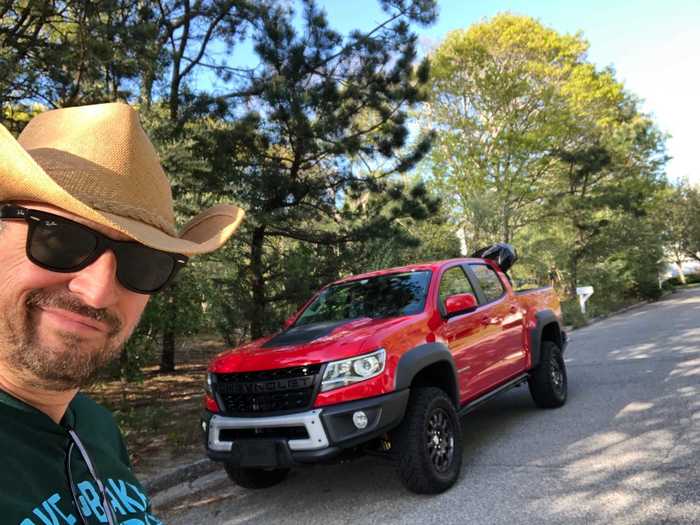
In an earlier comparison of the Colorado and the Ranger, the Chevy came out a nose ahead. Eventually, I'm going to review offroad-optimized and high-performance Rangers. But until then, the midsize that made the best impression on me was the Colorado ZR2 Bison.
Meanwhile, I recently review the new Jeep Gladiator Rubicon, and pound-for-pound, it's the biggest challenger to the Bison, although in many ways it might be too much of challenger. It's so capable that it doesn't really have a drive-around-town persona.
The ZR2 version of the Colorado was already by personal favorite midsizer, so it's unsurprising that the Bison upgrade blew me away. I don't think you can get a better all-around pickup — this guy does it all.
Basically, the ZR2 Bison is, as I wrote in my review, "the midsize equal of the [Ford] Raptor — a sort of Raptor junior, with the most extreme offroad market for midsizes to itself until Ford brings out a Raptoradelic version of the new Ranger."
At $49,745, this isn't a cheap pickup. But $6,000 of that is extras, which enable the Bison to go where few other pickups, mid or full, can go.
Don't get me wrong: the Ranger is a great truck. But the Bison is better than the Toyota Tacoma Pro or Sport, and that's saying something, given that those pickups are standard-bearers for rugged challenges.
Just quickly, if you don't want to tackle the backwoods, the GMC Canyon and the Honda Ridgeline are better choices: the GMC thanks to its upscale appointments; and the Honda due to its ease of use. In fact, for most suburban pickup wannabes, the Ridgeline is the perfect vehicle – it would be my choice if I were buying, given that I don't engage in any amateur offroading, but I do make frequent trips to my local garden center.
The Gladiator is probably the coolest-looking and most capable midsize pickup money can currently buy. It's off-road cred is superior to the Chevy Colorado, although if you go for the ZR2 Bison trim level of the Chevy, you're giving the Jeep something to think about.

The 8.4-inch infotainment touchscreen is small by current industry standards. But the system runs Fiat Chrysler's excellent UConnect system. UConnect is an industry underdog, but we've found it matches up well against the competition. It does everything well, from GPS navigation to Bluetooth and USB device connectivity.
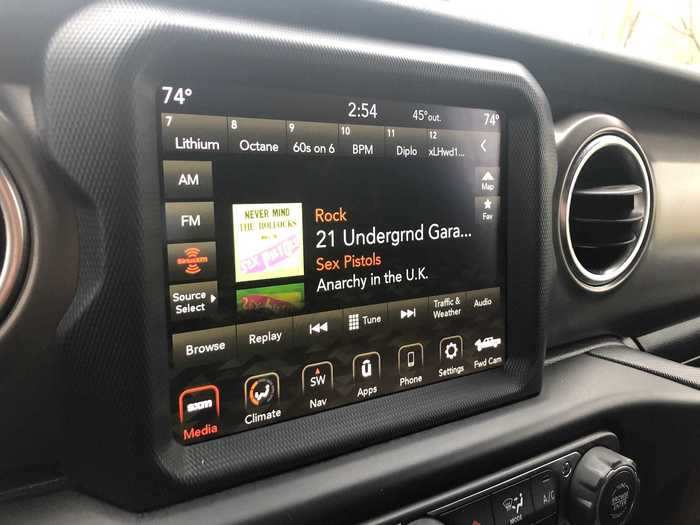
Throw a few latches and the entire room above the front seat can be removed. The rear roof is also removable, but it requires a small (included) tool kit.
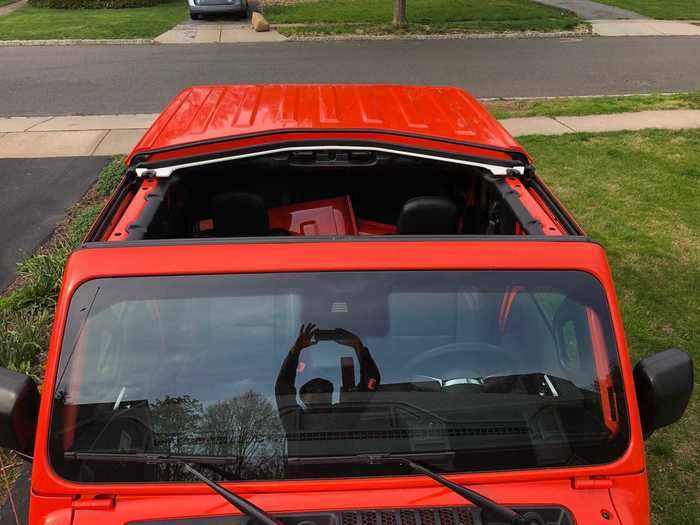
The Gladiator Rubicon's interior was basic black, with some orange contrast stitching and a bit of brushed metal. Actually, rather premium for a Jeep! Heated front seats!
That's a 3.6-liter V6, making 285 horsepower with 260 pound-feet of torque. Fuel economy is not great: 17 mpg city/22 highway/19 combined.
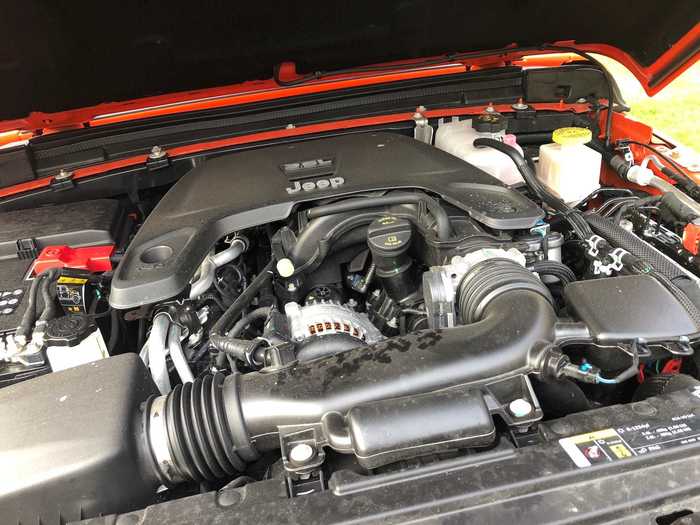
The power can be sent through an optional eight-speed automatic, with four-wheel-drive capability. A six-speed manual is standard.
The bed has a 1,600-pound capacity and could handle most of what its target customers would put in it, ranging from camping gear to mountain bikes. My review car didn't have a spray-on bedliner, but the cover somewhat eliminates the need for the additional protection.
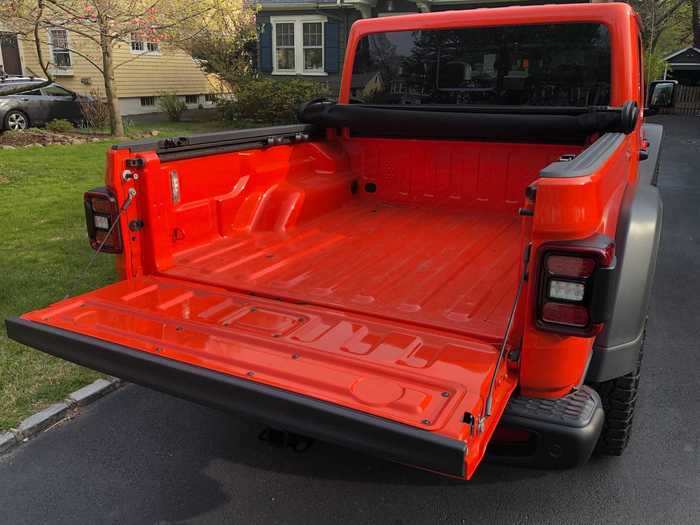
My Gladiator had a $350 towing package. It can manage 7,000 pounds. Other trim levels can tow more, up to 7,650 pounds.
There are heavy-duty front and rear axles that can be locked, a heavy-duty four-wheel-drive setup, a shielded gas tank, a shielded transfer case, and a front skid plate. All this for around $60,000 represents staggering off-roading capability.

The bed, which of course gives Gladiator its pickup-truck status, is a five-foot box, typical for the crew-cab midsize segment. My tester was outfitted with 33-inch all-terrain tires. But obviously, the Gladiator's wheel-arches could accommodate bigger rubber. The wheels were 17-inch "Granite Crystal" aluminum jobs, and they were standard.
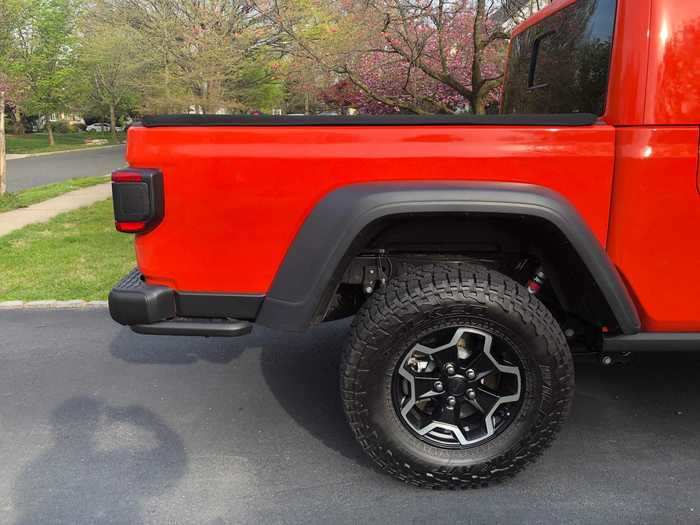
What we're really dealing with here is the blessing/curse of the Jeep design language. Up front, the Gladiator of course looks very, very much like a Wrangler.
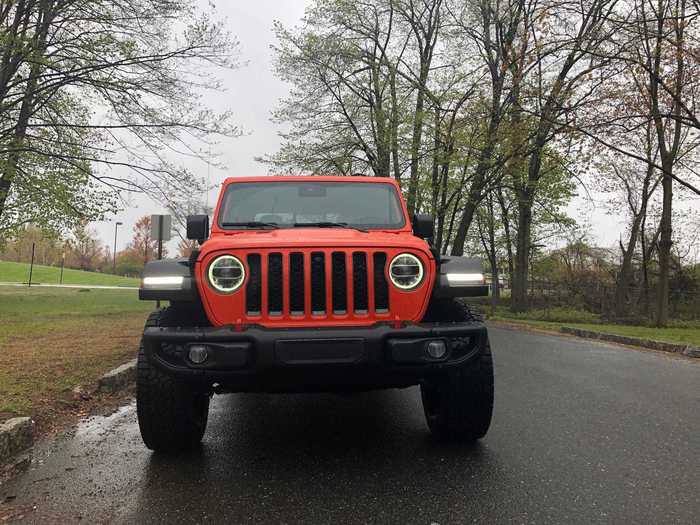
You might think that, like certain Jeep pickups of the past, the Gladiator is simply a Wrangler with a bed bolted on. Not so! The Gladiator sits on its own, dedicated pickup-truck frame.
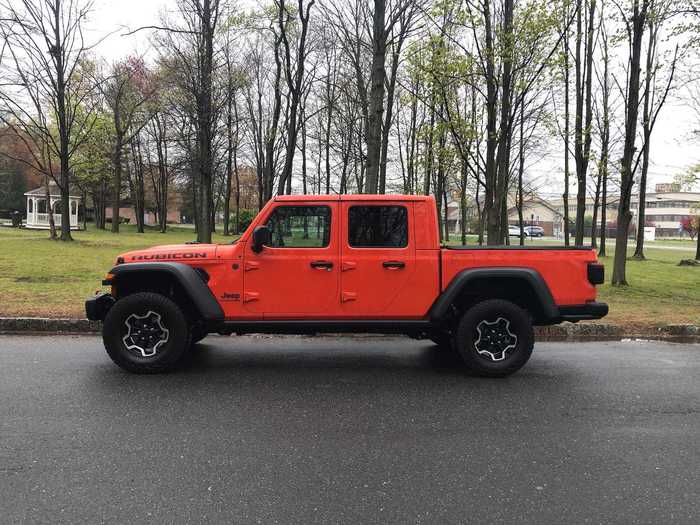
My $62,020 Jeep Gladiator Rubicon is the top-grade Gladiator. My 2020 model wore a "Punk'n" paint job.
The Toyota Tacoma TRD Sport is just about the most basic midsize pickup I've tested. If you don't hanker for creature comforts, it might be your baby.
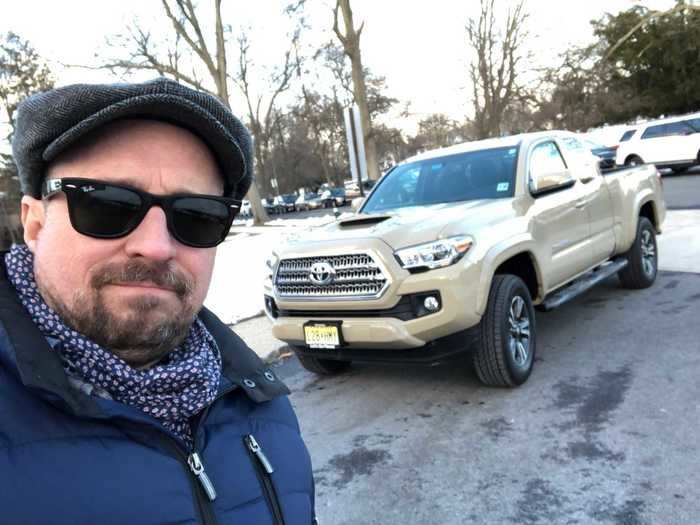
The Tacoma TRD Sport's setup for the driver is downright minimal. The only nod to luxury is the leather-wrapped steering wheel.
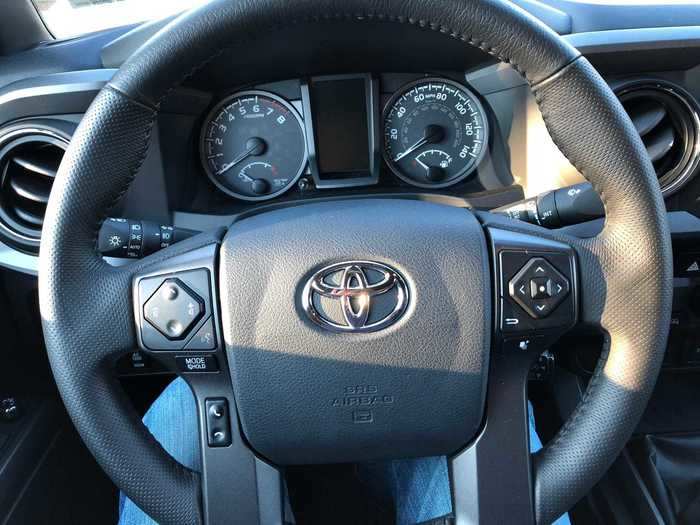
The interior was rather spartan, right down to the synthetic upholstery and the rear jump seats.
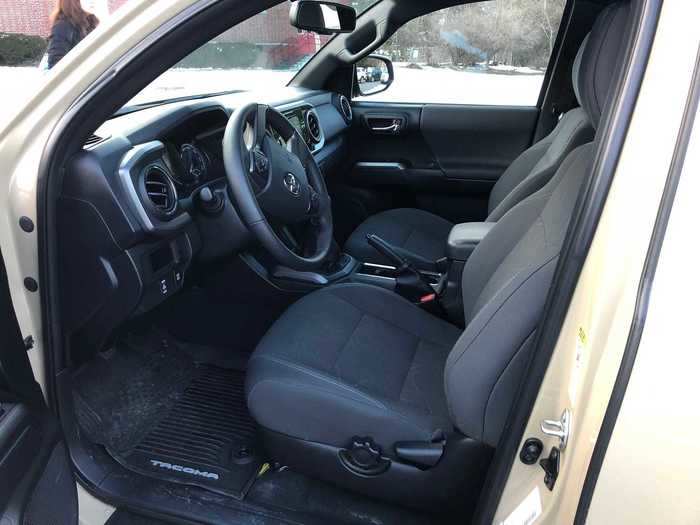
My Tacoma TRD Sport had a six-speed manual. Shifting was clunky, but also very truck-like. That's the thing about the Toyota Tacoma: It wants to consistently remind you that it's a pickup. I always struggled to get the thing into reverse. Over time, you'd probably develop the right feel, but it was frustrating. This pickup can be had with a six-speed automatic, however.
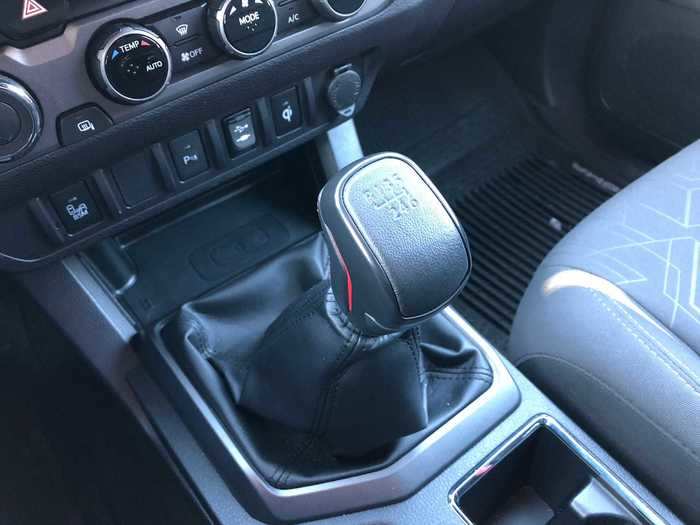
The Tacoma's 3.5-liter V6 puts out 278 horsepower. It also yields a 0-60 mph time of around 7.5 seconds.
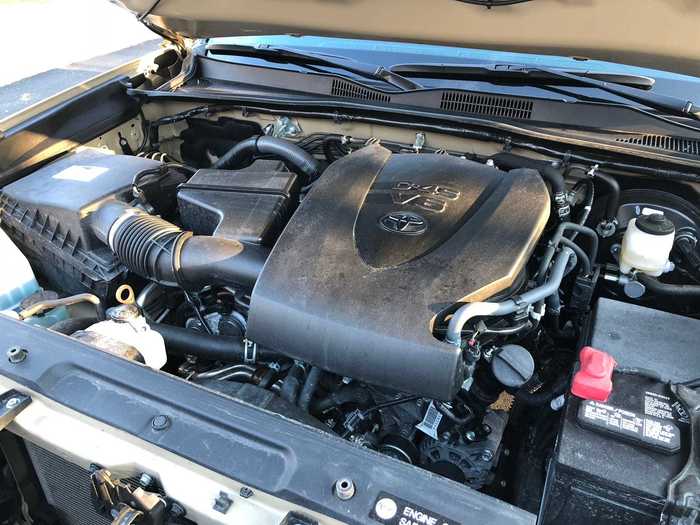
Fuel economy is 17 mpg city/21 highway/18 combined. In practice, I didn't seem to burn through much gas at all over the course of about a week.
I did drive over some small snowbanks in the TRD Sport, and it brushed them off as if they were off-road hors d'oeuvres.
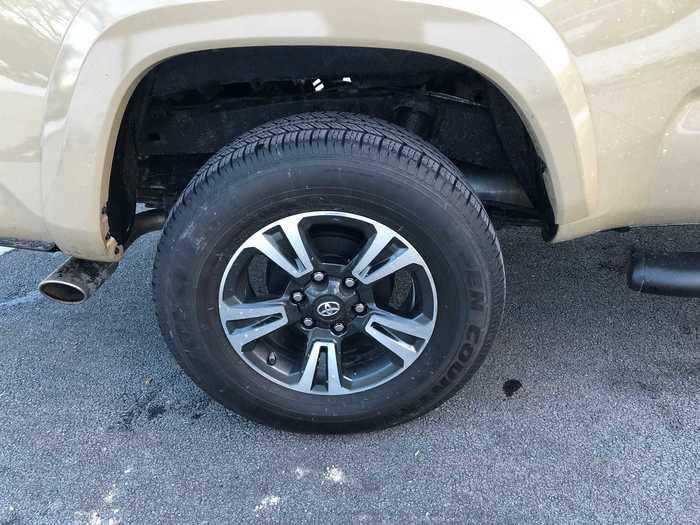
A late-winter storm meant the TRD's bed held mainly snow.
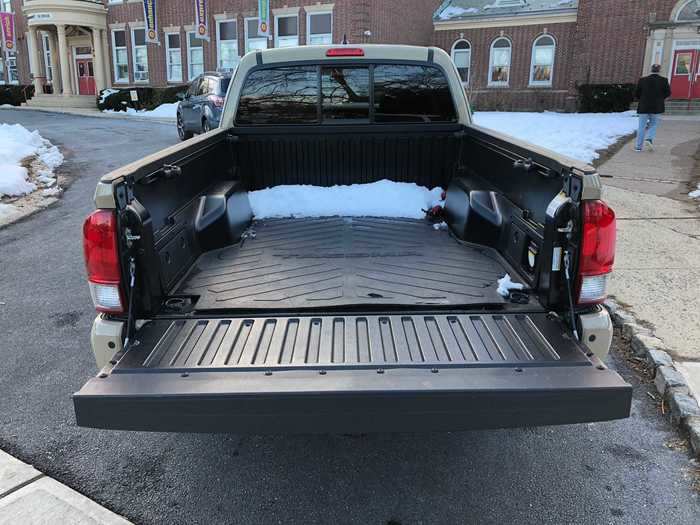
With a limited-slip differential and an electronic transfer case, plus some sport shocks, the TRD is ready to tackle the world beyond the pavement.
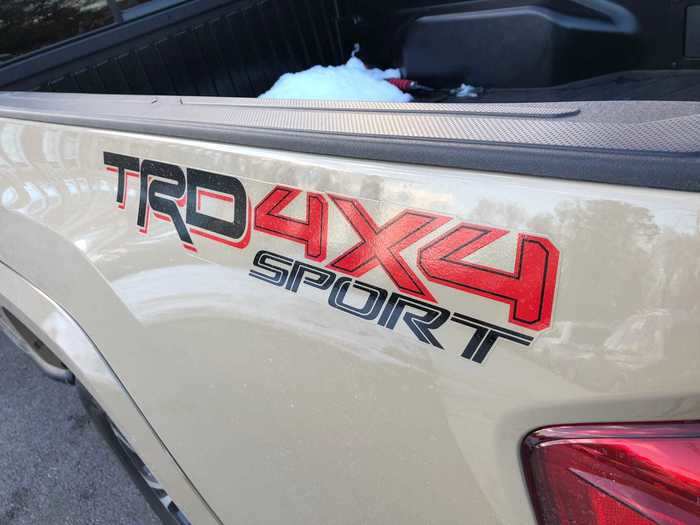
The front fascia of the TRD Sport is certifiably unattractive. But it is purposeful and "trucky,"
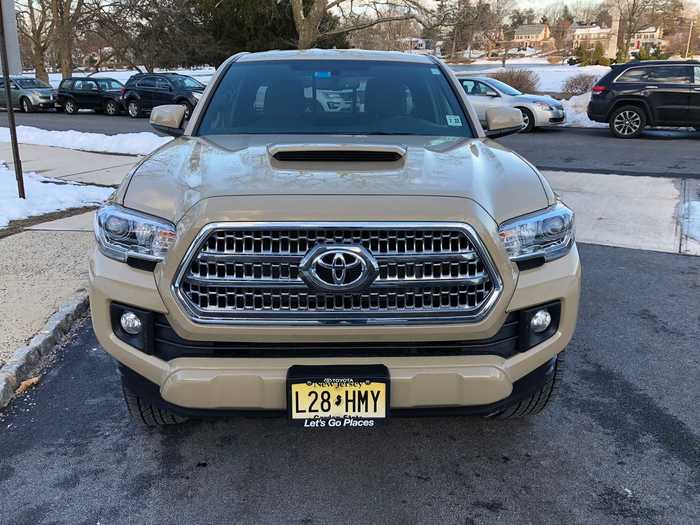
The TRD Sport came with an "access cab" — just two doors — and a longer bed than what I usually test, at six feet.
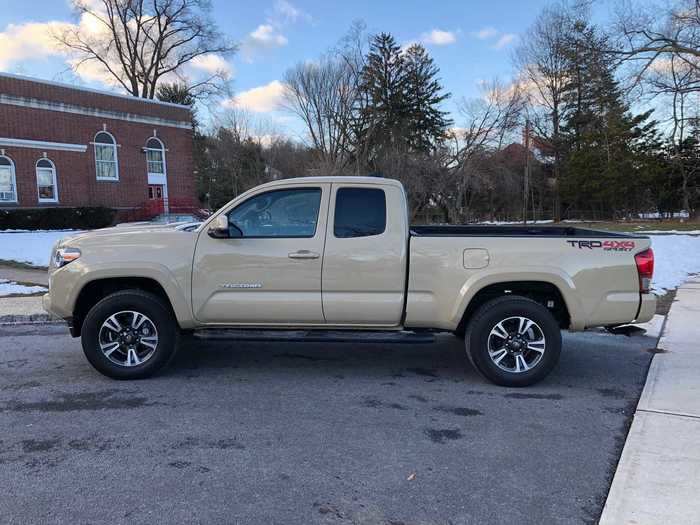
My 2017 Tacoma TRD Sport 4x4 came in a "Quicksand" paint job. The Toyota stickered at $38,031, which is a premium over the $25,000 base Tacoma.
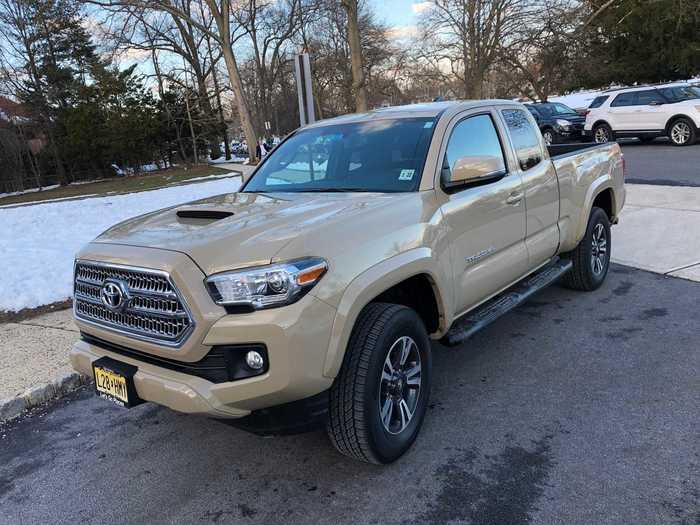
With four-wheel-drive engaged the TRD Pro meandered through a large and gummy expanse of mud as if it were freshly applied tarmac. I thought I heard the Tacoma softly laughing beneath the rumble of its torquey V6. "Is that the best you can do?"
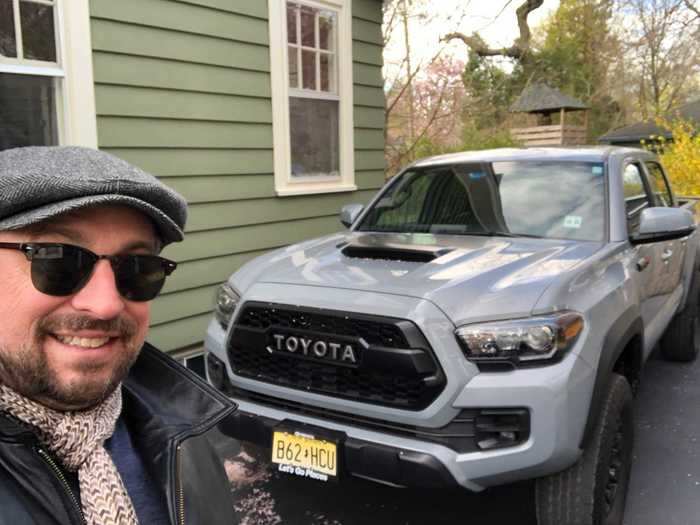
The TRD Pro's infotainment system shows up for duty, but the smallish 7-inch screen is out of step for the segment. We've had issues with the infotainment setup in all Toyota's vehicles, including those in its Lexus brand. The core functions are fine — Bluetooth paring, USB ports, navigation, Sirius XM radio.

The TRD Pro's interior was actually rather nice, for a tough off-roader.
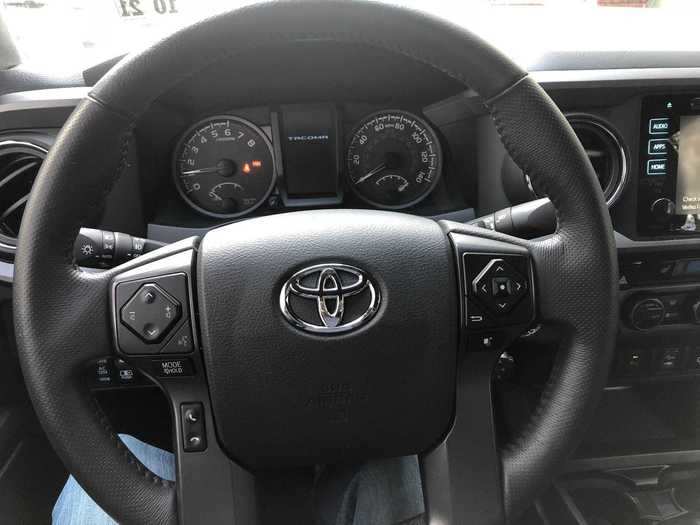
The Tacoma TRD Pro's 3.5-liter V6 puts out 278 horsepower. Same as the TRD Sport, but that's less than the ZR2's 308. However, as with the TRD Sport, the Pro's grunt is more visceral.
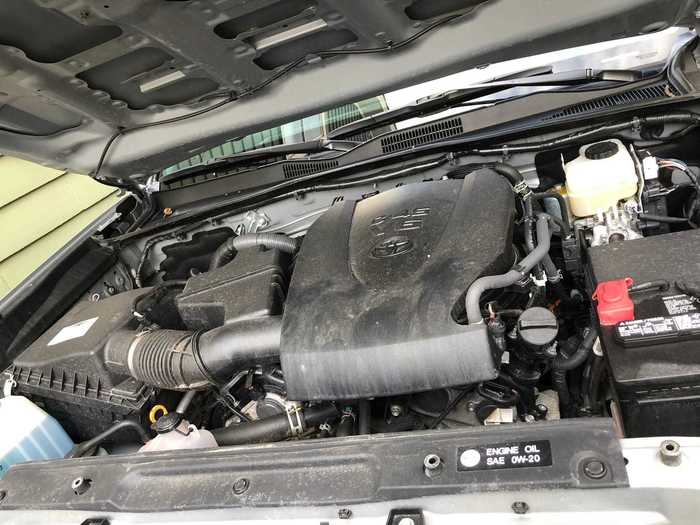
As with the Pro, the V6 also yields a 0-60 mph time of around 7.5 seconds. Not really crazy fast, but fast enough.
The transmission in my tester was a six-speed automatic.
Fuel economy is 18 mpg city/23 highway/20 combined. That doesn't sound all that great, but it beats the Colorado's. And in practice, I didn't seem to burn through much gas at all over the course of about a week.
At the gardening center, I drove around in some actual mud. The TRD Pro brushed it off without breaking a sweat.
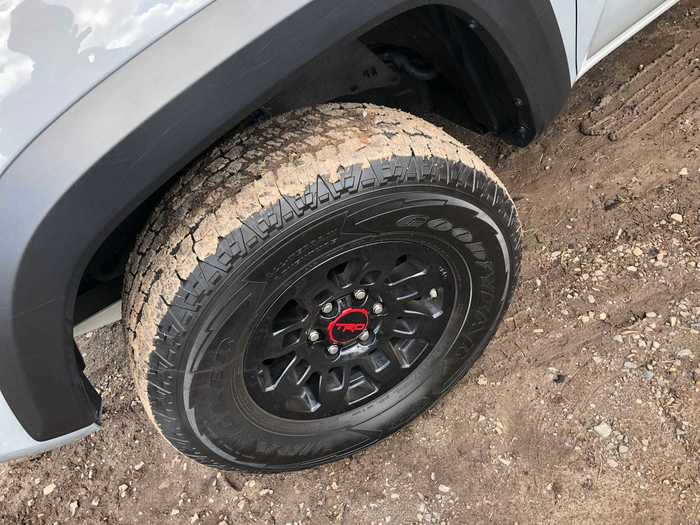
It alleviates the potential drawback of the short bed.
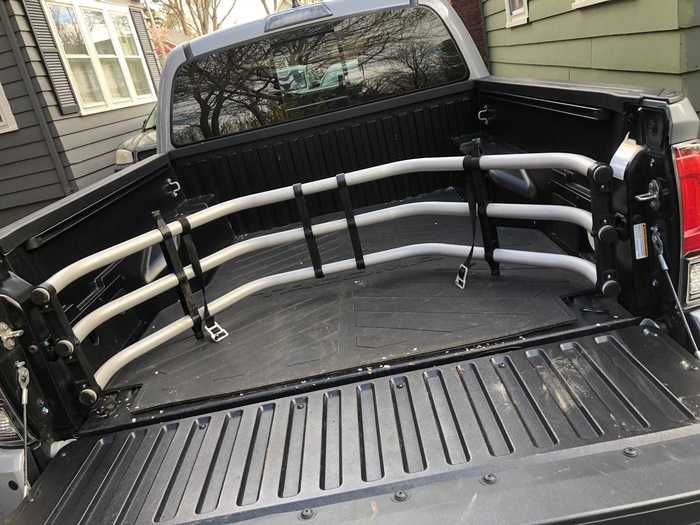
An extra $300 also gets you this very useful bed extender.
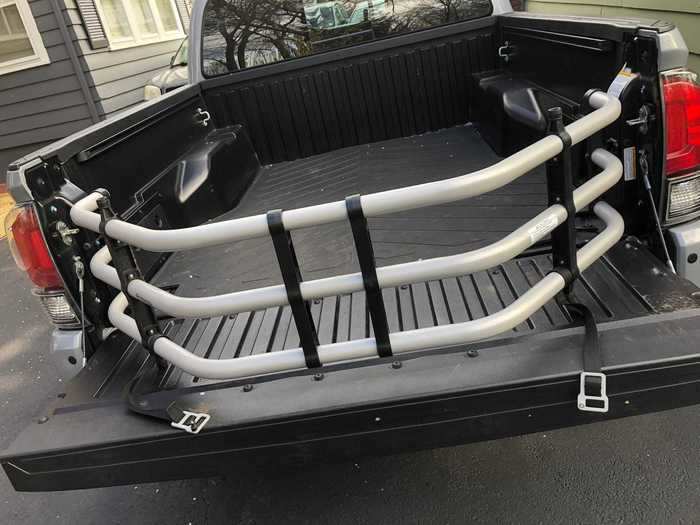
The bed swallowed up enough mulch and soil to repair my yard and garden from a brutal Northeastern winter.
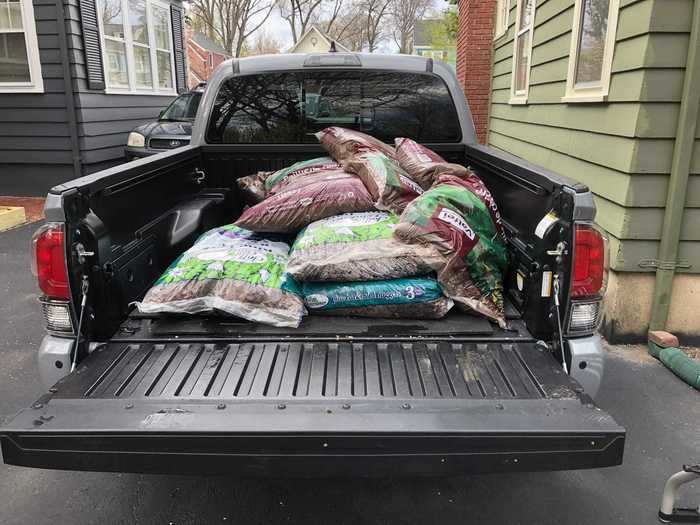
The Tacoma TRD Pro is purposeful and utilitarian. My tester had a short box.
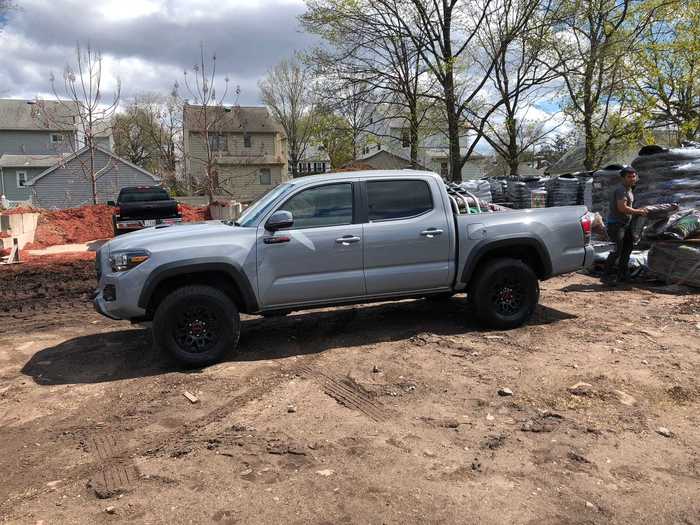
Now for the 2017 Toyota Tacoma TRD Pro! The paint job is "cement." Our 4x4 double-cab tester tipped the cost scales at $44,814, with just a few grand in options over the unadorned version the the truck. The base Tacoma comes in at about $25,000.
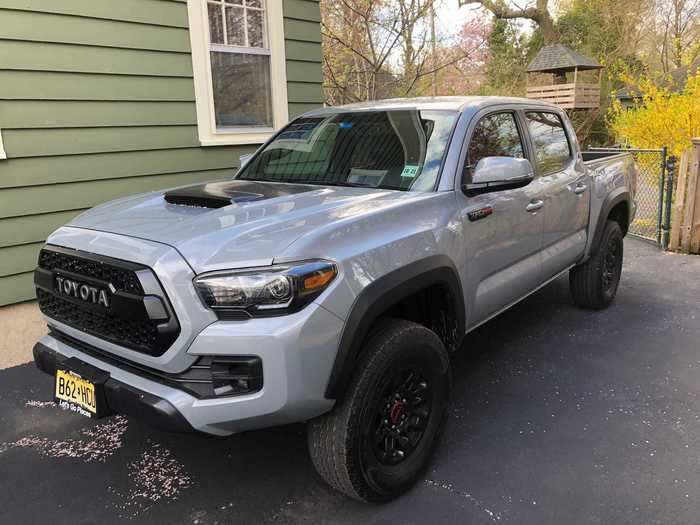
I used the Ridgeline to fetch a Christmas tree and a wreath. The Ridgeline is the closest thing you can get to a modern-day El Camino and is basically a perfect and versatile truck-car for people who don't need to engage in rancher- or contractor-grade work,
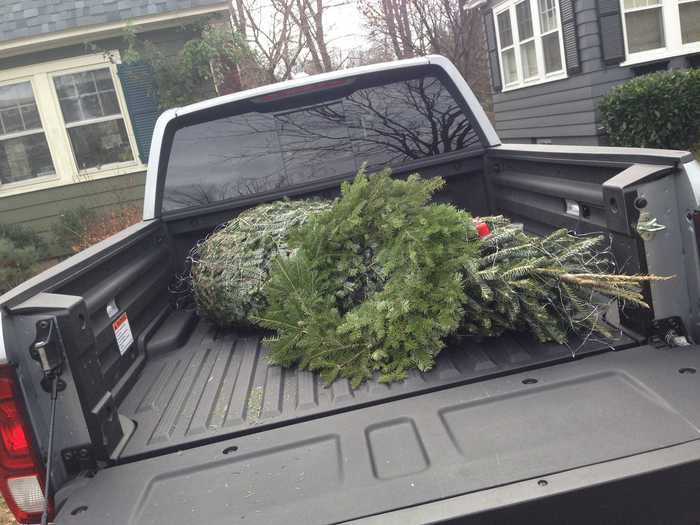
The "box" matters to pickup-truck buyers. Honda's more than gets the job done — and it has a cool side-swinging gate.
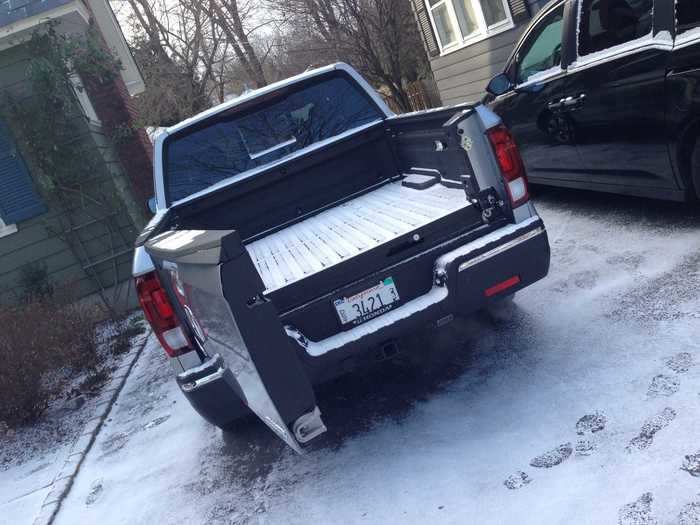
The Ridgeline is a four-door crew cab, and the bed is about the same size as the Canyon Denali's, but with an in-bed trunk that increases storage. The platform the Ridgeline is built on is less pickup than crossover, shared with the Honda Pilot.

Our 2017 Ridgeline tester tipped the cost scales at $41,370, and it landed at BI's suburban New Jersey test center after a light winter snowstorm in late 2016. The base pickup is about $30,000.
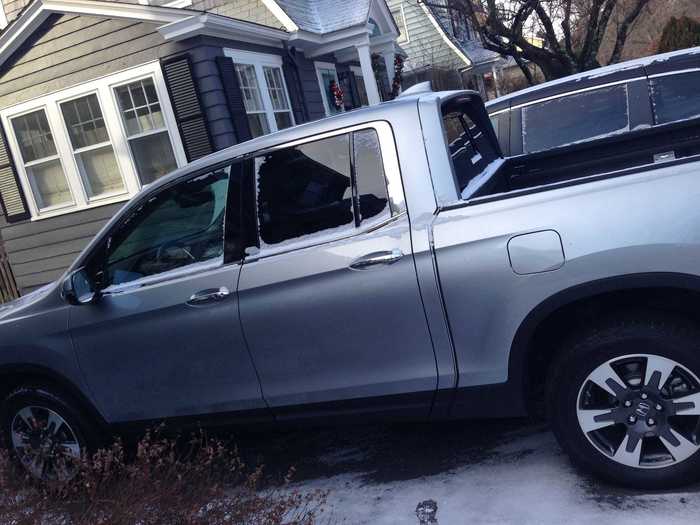
The Rideline's powerplant is a 3.5-liter, 280-horsepower V6. This is one of the world's great motors, perhaps the best V6 anywhere. Mated to a six-speed automatic transmission, this engine is more or less perfect and provides 21 mpg in combined city/highway driving.
The Honda Ridgeline has always been a sleeper. In 2016, Honda ditched its polarizing styling and redesigned it to be a more traditional pickup.
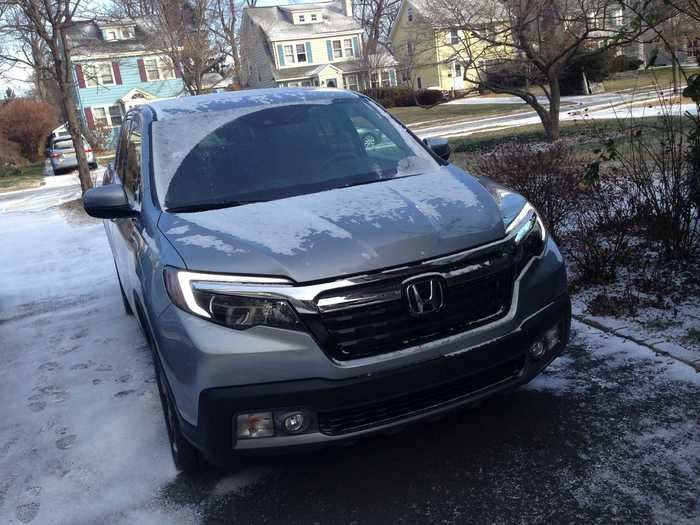
The Canyon Denali is a great choice if you're looking for a premium small pickup — with the accent on "premium."
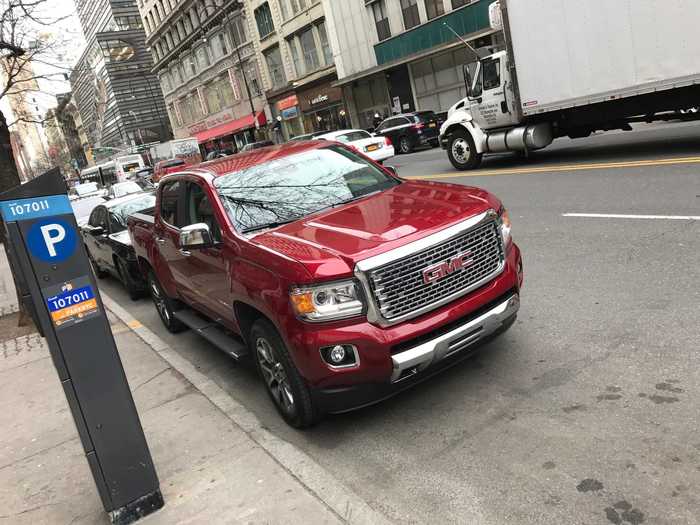
The Canyon I tested used essentially the same infotainment system as the Chevy Colorado.
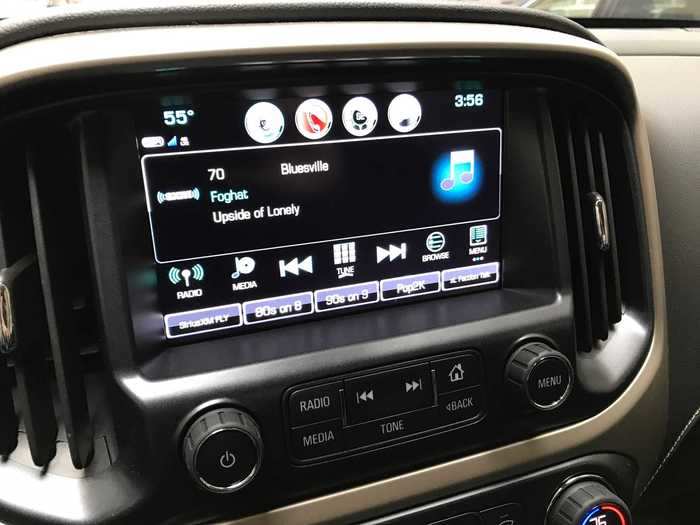
From the driver's seat, in the Canyon Denali you see all the usual gauges and have controls on the steering wheel, an the interior itself has a near-luxury quality.
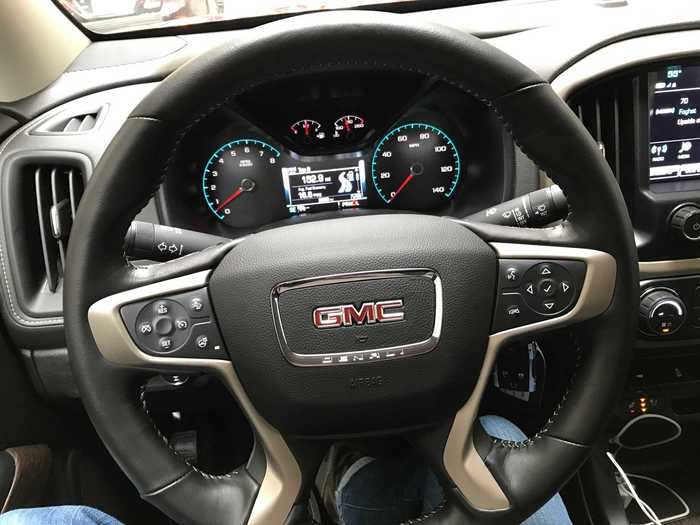
The Canyon Denali is outfitted with a 3.6-liter V6 that makes just north of 300 horsepower and pipes the power to, in the case of our tester, an all-wheel-drive system through an eight-speed automatic transmission. The motor feels robust and quite trucky, which is to say a tad crude (the same engine is found in the Cadillac XT5 and comes off as much more refined).
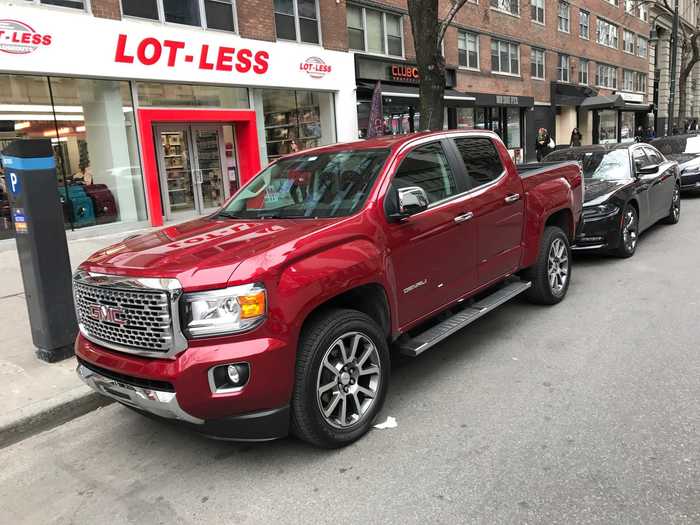
This is a powerplant that can roar. The Canyon Denali also has a towing mode that can handle 7,000 pounds, about 2,000 more than what the Honda Ridgeline is rated for.
What are pickups for? Putting stuff in the back! We took the Canyon Denali on a run to Home Depot and loaded up on rocks. No sweat for this truck, which was built for work.
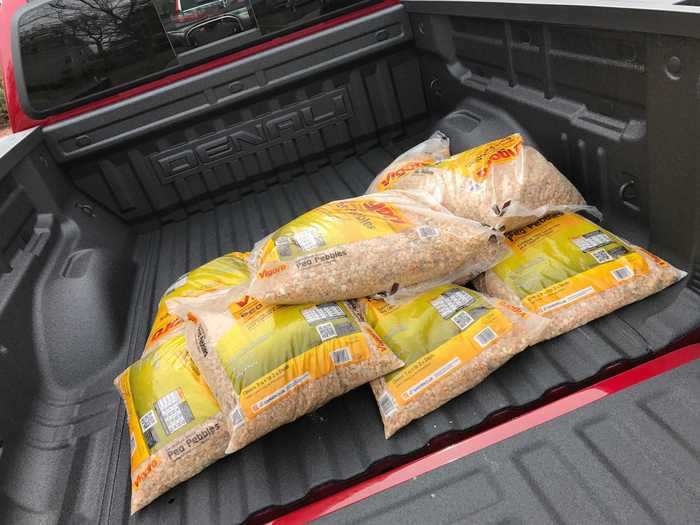
There's no debating it: The General Motors truck buyer-ship wants its pickups to look like trucks.
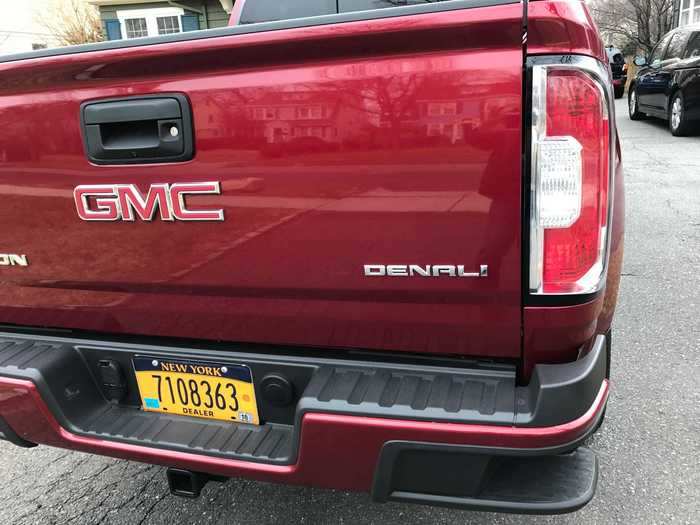
You can really see the pickup-truck DNA when you study the Canyon Denali's hunky, slab-like front end.
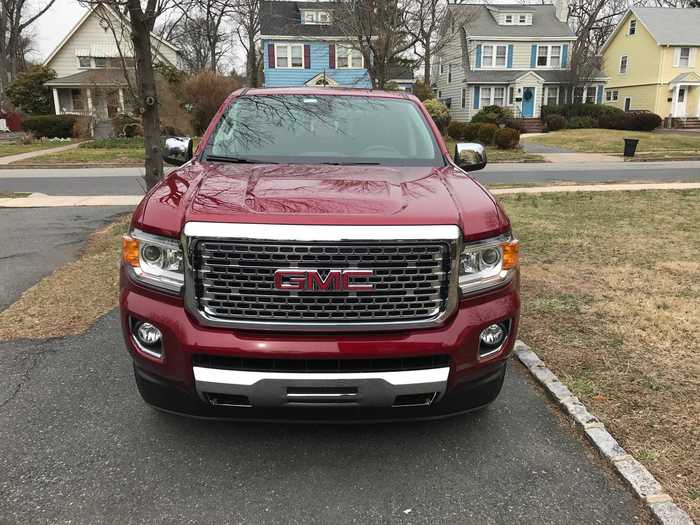
The 2017 Canyon Denali arrived early in the year, during a respite from winter's snow and ice, but before the weather warmed. Truck conditions! Price? $44,255, as tested. The base GMC Canyon, without the upmarket Denali trim features, is about $22,000.
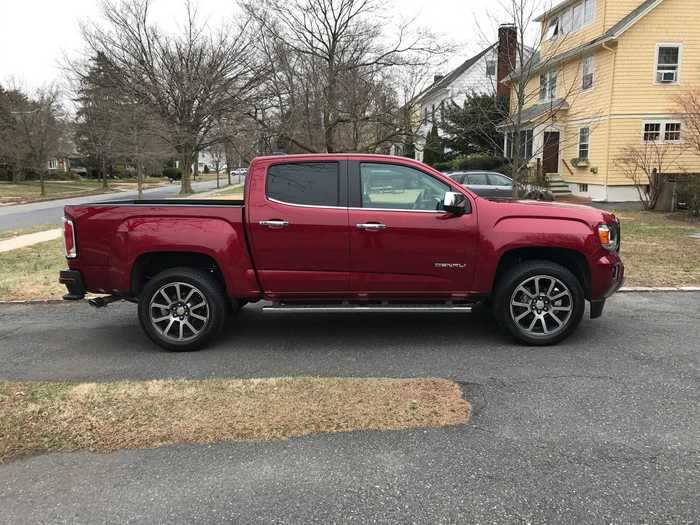
Our Canyon Denali was a crew-cab version with a "short box" — the bed is about five feet long, protected by a bedliner.
Heavily modified for maximum off-roading, the Bison is a massive amount of pickup for the money.
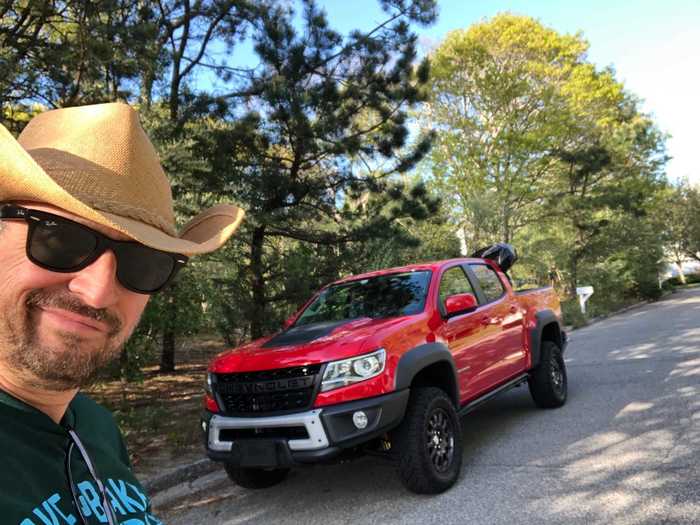
And comfort is an added perk. But then again, people who drop the $6,000 extra are likely to spend more time offroad in their ZR2 than on pavement. If you're trying to make a choice between the ZR2 and the Bison, be real: the ZR2 is plenty of truck for folks with day jobs that don't entail daily dirt and jagged rocks.
But the ZR2 Bison is something special.
The infotainment system runs on an eight-inch touchscreen. It lacks map-based navigation features, but it can provide OnStar turn-by-turn directions. Apple CarPlay and Android Auto are available. Bluetooth connectivity is a snap, and there are USB/AUX ports for devices. The pickup has 4G LTE Wi-Fi, too.
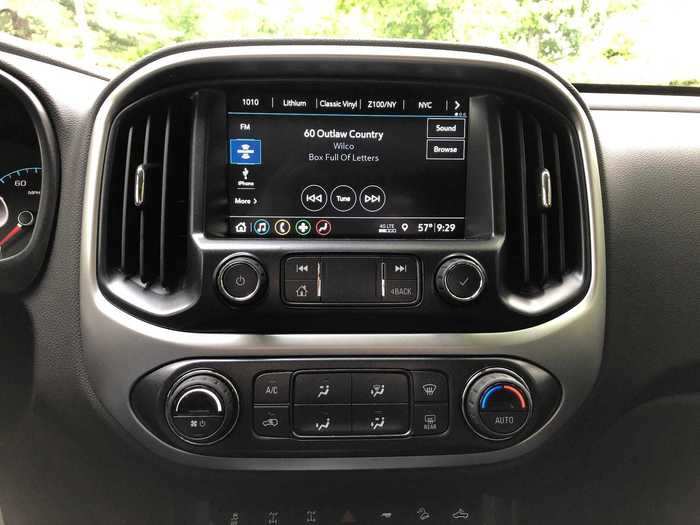
Like the ZR2, the ZR2 Bison has a nice — but not overly premium — interior. My tester's was "Jet Black." Front seats were heated, as was the steering wheel.
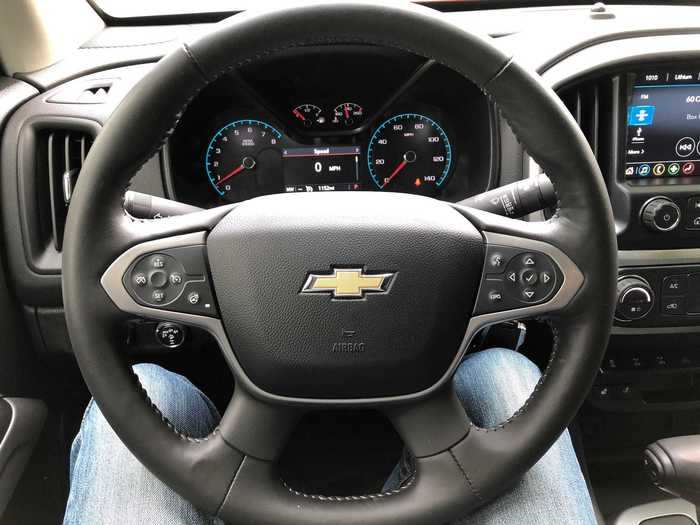
The 3.6-liter V6 is all motor — no turbos. The engine makes 308 horsepower with 275 pound-feet of torque. A turbocharged four-cylinder, 2.8-liter mill is available, making 181 horsepower but a juicy 369 pound-feet of rock-crawling torque.
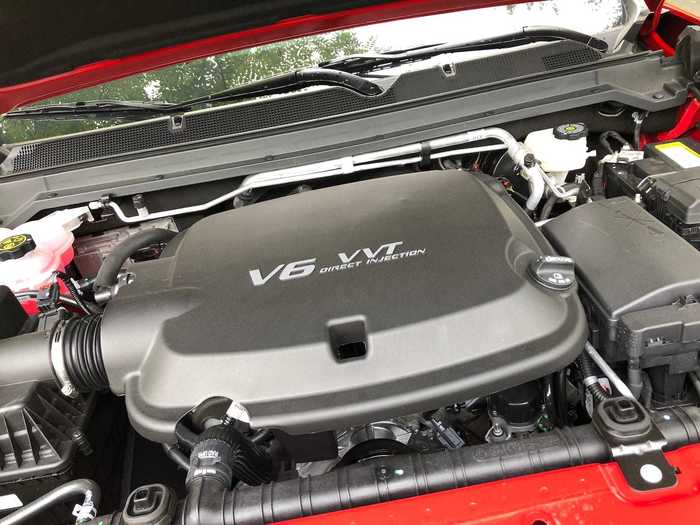
My tester sent the power through a stout eight-speed automatic. This combo yields less-than-great fuel economy: 16 mpg city/18 highway/17 combined. My jaunt to Long Island plus a week driving about town meant that I had to top off the tank at least once.
These tires aren't messing around. They also aren't the best for highway cruising, but they weren't outrageously rough or noisy in my testing.
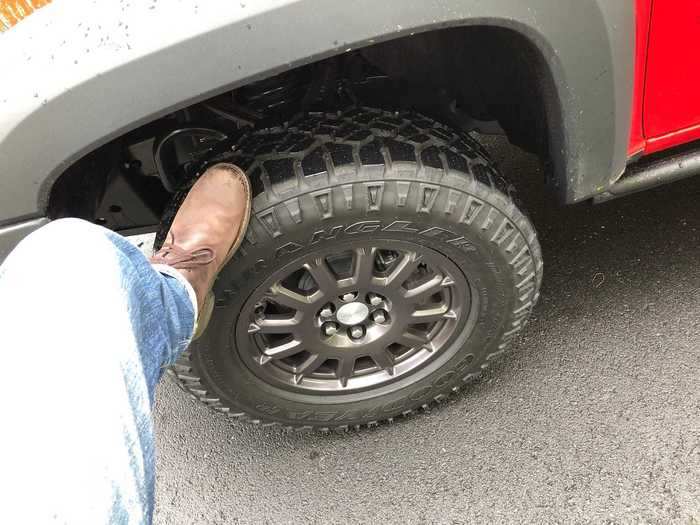
The bed is as versatile as you'd expect, even if it's a short one (which actually helps with offroading, making the ZR2 Bison easier to handle). I made a long run from New Jersey to the East End of Long Island to fetch a pair of houseplants. As you can see, I had plenty of room for a hammock, too.

So what makes a ZR2 Bison a member of a special herd of pickups? Basically, it comes down to a collaboration with American Expedition Vehicles, a Montana-headquartered company with close ties to Detroit.
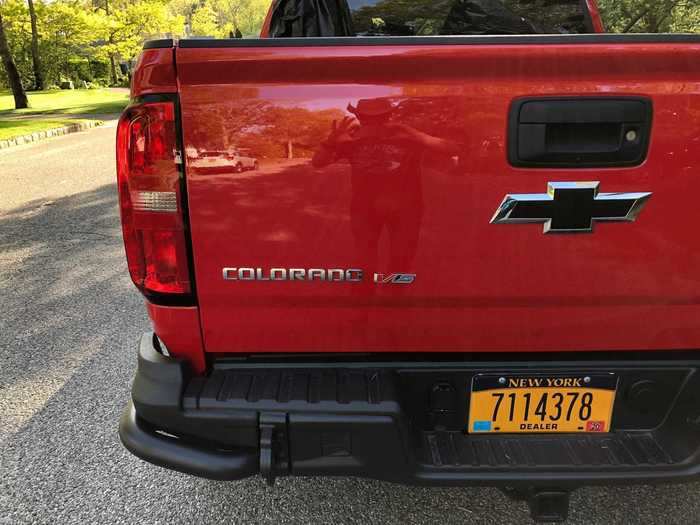
"For maximum protection of key undercarriage elements while driving over rocky, jagged terrain, Bison features five skid plates covering the engine oil pan, fuel tank, transfer case and front and rear locking differentials," Chevy explained when the new ZR2 was launched.
"Designed by AEV, these skid plates are constructed of hard, durable hot-stamped Boron steel. AEV-designed stamped steel front and rear bumpers further shield the truck from obstacles. The front bumper contains winch provisions and standard fog lights, with recovery points integrated into the rear bumper."
The upshot here is that while the ZR2 is extremely capable, the ZR2 Bison is capable and then some. If you spend your spare time busting over rocks, climbing hills, and fording rivers — in other words, if you consider pavement something for the weak — then you'll be interested in what the Bison spec has to offer.
Effectively, the ZR2 Bison is a Colorado ZR2 with an armor-plated underside. Hot-stamped Boron steel! That sounds pretty impressive.
The ZR2 also has locking front and rear differentials and some other offroad goodies; the Bison upgrade adds about $6,000 in extras, including some rather stout-looking floor mats.
The Bison carries the proud Chevrolet name on the blacked-out grille, rather than the bowtie Chevy badge.
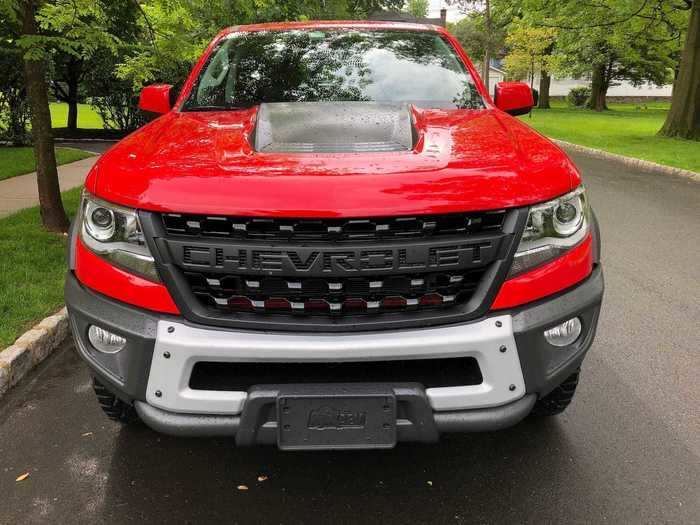
Our Chevy Colorado ZR2 Bison tester came with a crew cab and a short box. It also had $6,000 of upgrades from American Expedition Vehicles, all designed to improve the pickup's ability to go where no midsize pickup has gone before.

Say hello to the Chevy Colorado ZR2 Bison! The 2019 Chevy ZR2 Bison, to be precise. In a "Red Hot" paint job, this test truck stickered at $49,745.
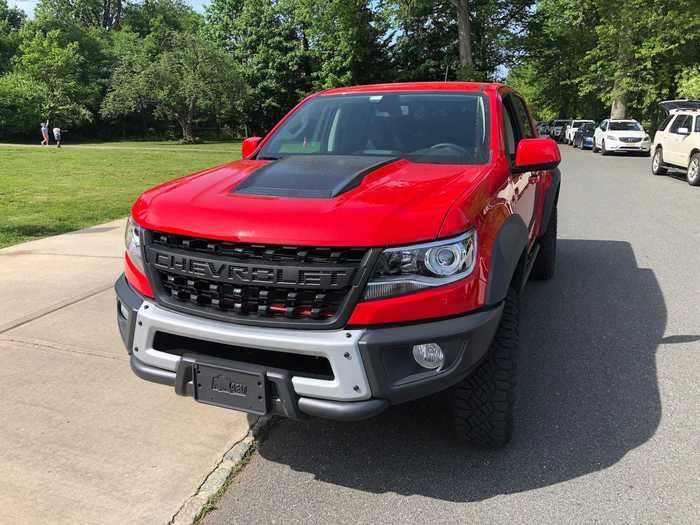
The Z71 is just a 4x4 Colorado with some added flash and beefed-up performance aspects. So if you have plans for your Colorado that might be more on the brash side, and if you don't mind the menacing appearance, the Z71 trim is at least worth a gander.

The Colorado Z71 just feels beefy for a midsize pickup, even if the 0-60 mph dash happens at a relatively leisurely seven or eight seconds. The velocity just feels more substantial, thanks to the V6's horsepower.
The 8-inch touchscreen runs Chevy's superb MyLink infotainment system. Note the knobs and buttons. Sometimes the old ways are the best, especially when it's cold and you're wearing gloves.
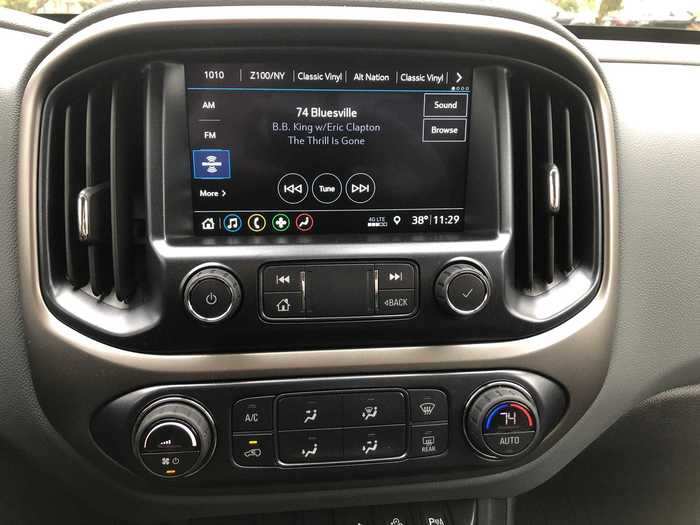
The Colorado doesn't have a crazy-awesome audio setup, but it sounds fine. Apple CarPlay and Android Auto are also available, as is 4G LTE WiFi, along with the usual USB/AUX ports for devices.
[Editorial Note: The ZR2 and the Z71 hit our suburban New Jersey test center at different times for the Chevy infotainment system, which was updated between trucks.]
The rear seats in the "crew" configuration are a simple bench design. Adults can squeeze in, but we're not dealing with a full-size rig here.
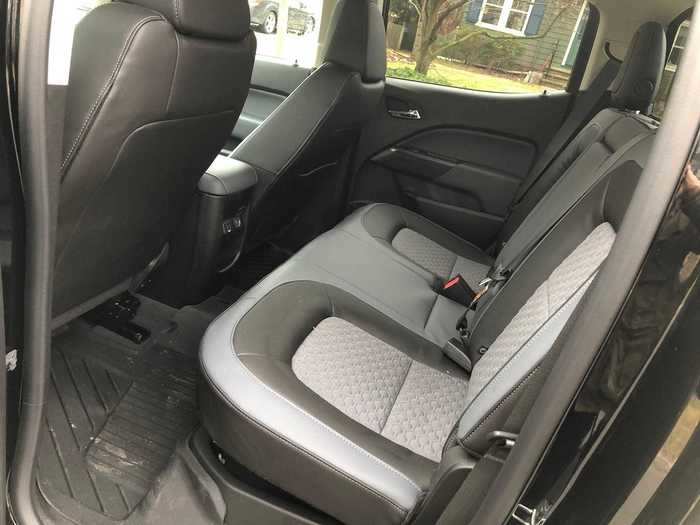
The black interior is nothing fancy. The seats are comfortable, but the synthetic upholstery and heavy-duty floor mats are intended to endure abuse. The seats are heated — a nice touch.
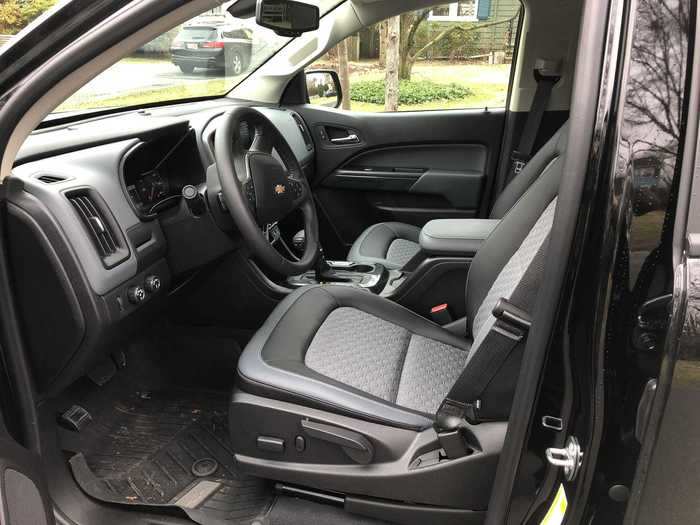
The 3.6-liter V6 makes a purposeful 308 horsepower and is a reminder in the age of turbocharged four-pots that GM has always been good at sixes. Fuel economy is an appealing 17 mpg city/24 highway/19 combined — not great, but also not bad given the oomph provided by the V6. The eight-speed automatic handles the Colorado Z71 power without straining. Shifts are smooth.
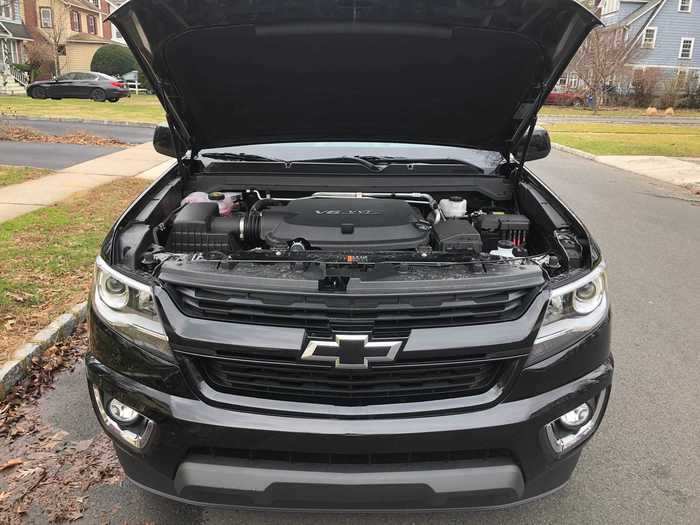
The Z71 also boasts serious off-road cred, with all-terrain tires and a proper four-wheel-drive system, complete with a locking differential and a hill-descent mode.
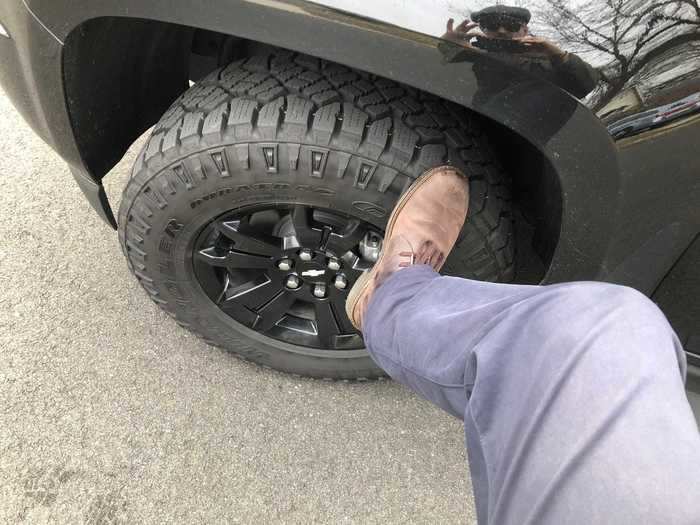
Short boxes are fine for sport trucks. A bigger bed is what you need for hauling house-building supplies, not mountain bikes. If it isn't enough, you can always hitch up a trailer. The Colorado Z71 with a V6 motor can tow an impressive 7,000 pounds.

The blacked-out bowtie badge is replicated on the liftgate.
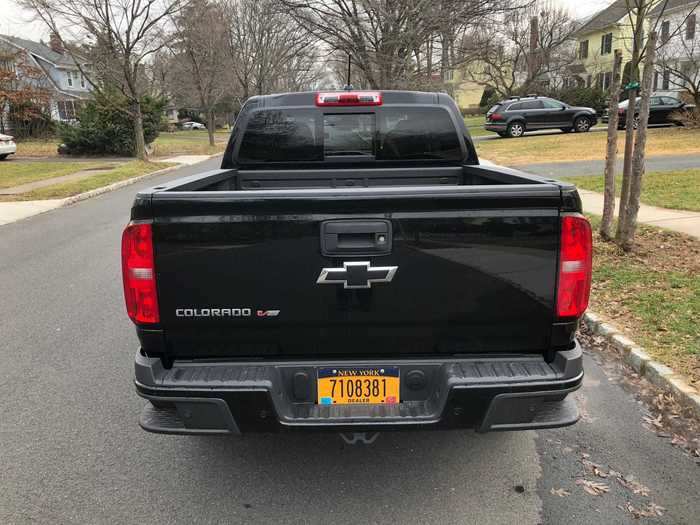
As far as the "Midnight" package goes, Chevy isn't messing around! The Colorado was all blacked out, with both the grille and the Chevy bowtie marque given the noir treatment. Not exactly chrometown.

The "Midnight Edition" special package added roughly $5,000 to the base price of $37,000. As tested, the truck was $42,000.
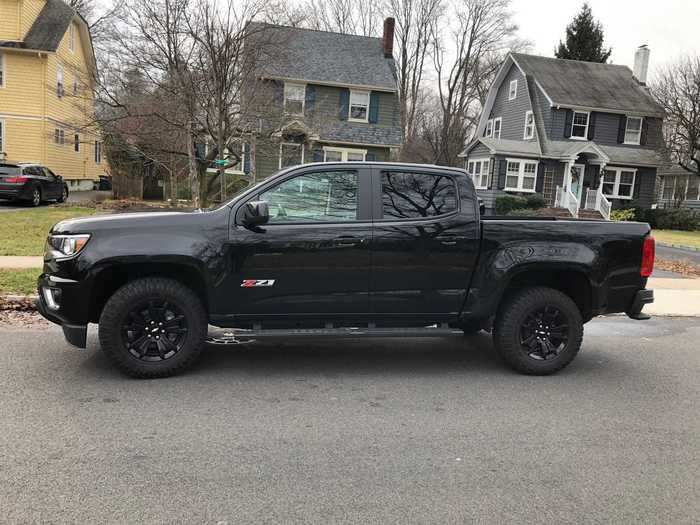
The Z71 "Midnight Edition" Colorado I tested brings edge and aggression to this Pickup. The base Colorado is a versatile contemporary midsize pickup, and the ZR2 is at-home off-road. But the Z71 gets you noticed.

Chevy Colorado ZR2
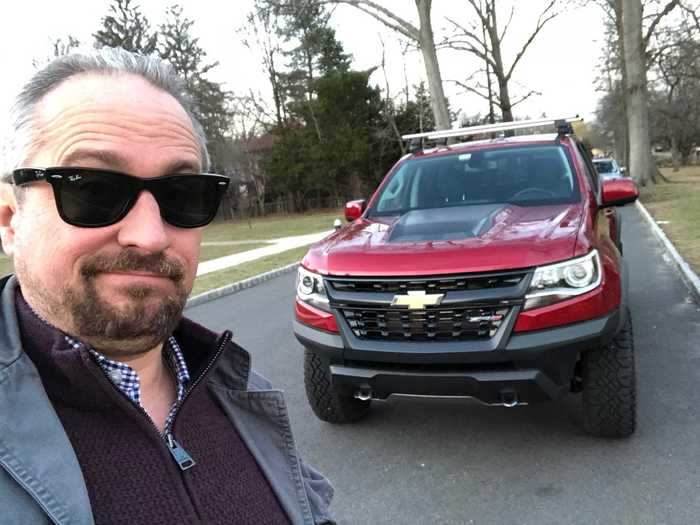
"You can sort of think of the ZR2 as a less intense, junior-ized version of the Ford Raptor or the Chevy Silverado Z71," I wrote in my review.
"Not that it isn't intense on its own. I think the smaller size and sportier demeanor would be quite a lot of fun to take to the desert, maybe more so than bigger and far more powerful high-end pickups."
And I added: "From a price-to-value-ratio standpoint, you're getting a lot of truck with the ZR2. If you lead an active, outdoorsy lifestyle, it's definitely worth a look. It will be able to handle pretty much anything you can throw at it.The ZR2 has the potential to do it all. Sure, it's going to perform better off-road than on. But it is plenty OK on-road for such as a capable machine. When you put it all together, it adds up to one of the best pickups I've ever driven."
The eight-inch touchscreen runs Chevy's Intellilink infotainment system. We've liked the system on all Chevys, and in the ZR2, it's up to snuff, although the screen is fairly small.
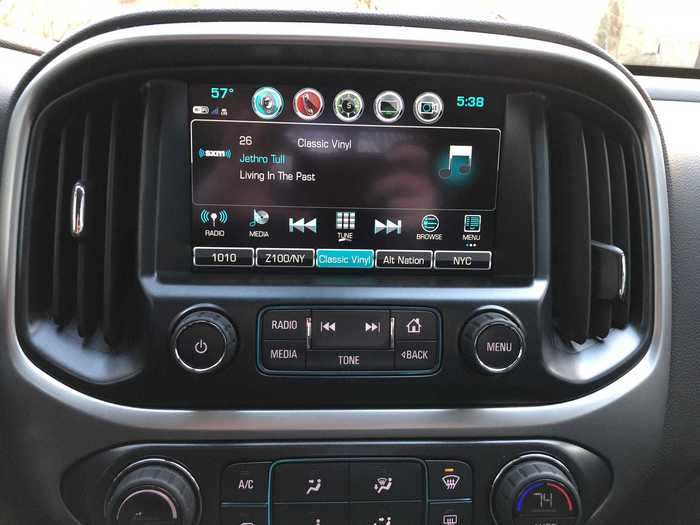
Bluetooth-device pairing is a snap, and there are USB/AUX options for plugging in gadgets. Like all GM vehicles, the Colorado ZR2 has 4G LTE WiFi connectivity. Our tester didn't have the Bose audio system that we've enjoyed in many other vehicles from the brand, but the more basic stereo still sounded pretty good when we fired up Classic Vinyl on SiriusXM.
And of course, the ZR2 has OnStar, for safety and as a voice-operated alternative to infotainment GPS navigation.
The back seats are a bench layout. The crew-cab setup is relatively roomy, but taller folks could find their knees bumping against the front seats.
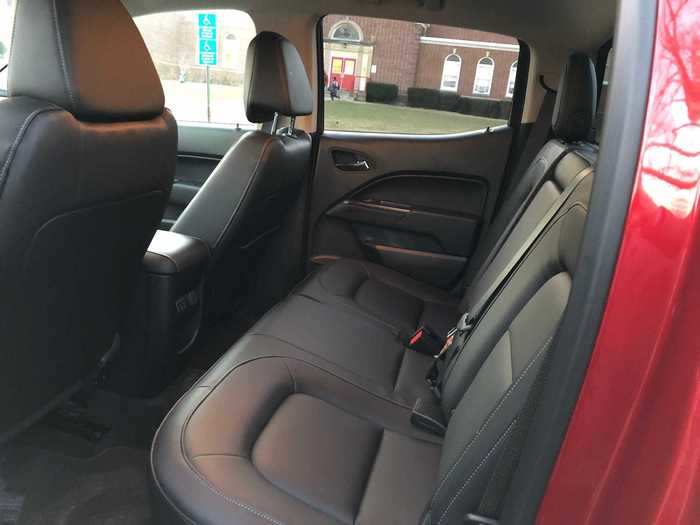
The "Jet Black" interior offered a nice environment, near-premium without being luxurious. That's by design. This isn't a truck that's meant to be babied, so the interior has to be able to endure some punishment.

On paper, the 308-horsepower 3.6-liter V6 could be construed as underpowered. But it was anything but in my hands. This pickup has nice pop.
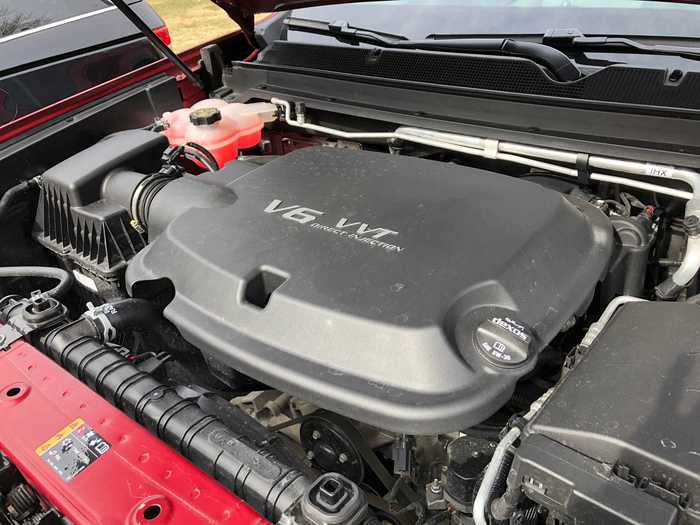
The ZR2 power is channeled to the 4WD system through an eight-speed automatic transmission.
The ZR2 has been clocked at a respectable 0-60 mph in 6 seconds. The motor is smoothly responsive, with solid if not stunning torque. I'm a fan of naturally aspirated V6 engines that simply get the job done. The ZR2's six-pot is a stout motor that's not likely to give owners a lot of trouble.
The ZR2 can tow up to 5,000 lbs. That's not massive for a pickup, but the non-performance Colorado and ZR2 aren't really intended for customers who will be hauling horse trailers. More likely, they'll attach a small trailer to pull an ATV, some JetSkis, or a modest camper.
Fuel economy is meh: 16 mpg city/18 highway/17 combined. But you don't buy a performance off-roading pickup to save on gas.
The short bed isn't all that large by pickup standards, but it would easily handle all my needs. Plus, if you do use the ZR2 for off-road action, the more compact design helps with performance.
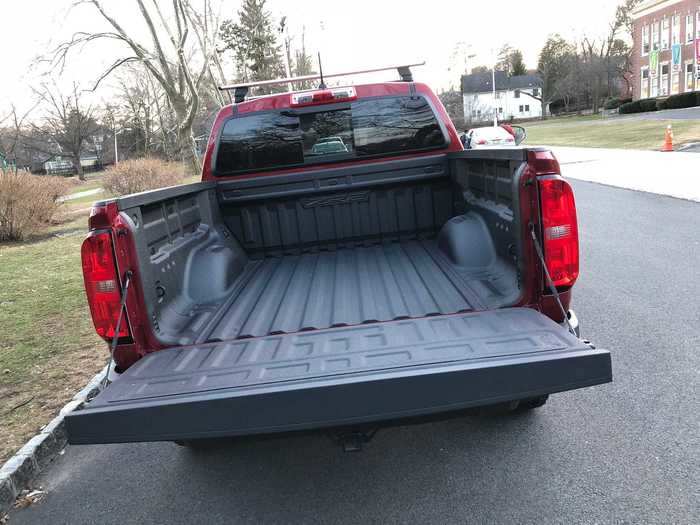
Colorado badging on the rear — and reminder that the ZR2 rocks a V6 engine, versus the base Colorado's turbocharged four-cylinder.
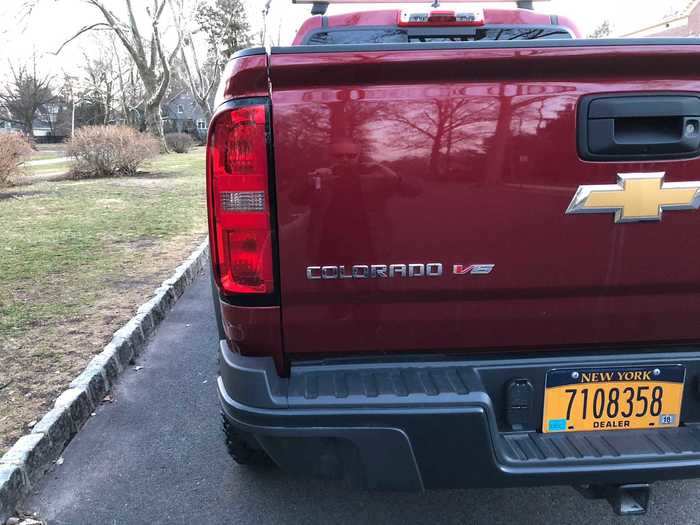
My ZR2 had some sweet knobby tires and 17-inch aluminum wheels.The Colorado ZR2 is a proper, lifted, four-wheel drive upgrade. Still a pickup, however. Check out those leaf springs in the rear suspension.
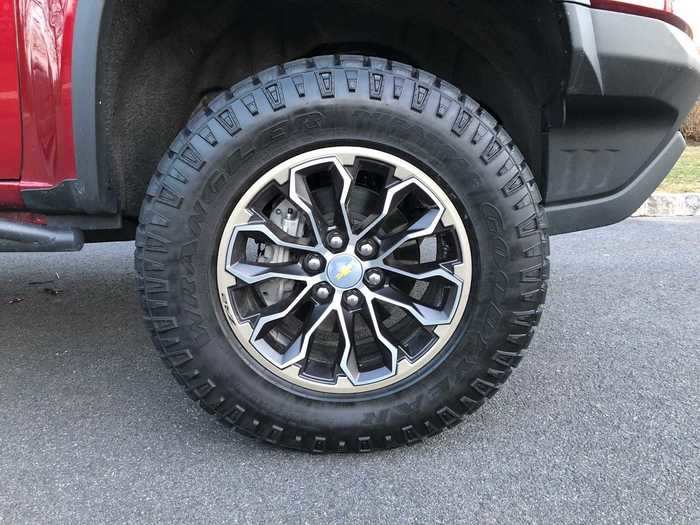
You have electronic-locking differentials, front and rear, so the Colorado ZR2 is ready for serious off-roading. The front underbelly and rear transfer case are also shielded, so rock-busting won't cripple your pickup.
The Colorado ZR2 kind of blends aggression with sporty sleekness. Personally, I don't think the various fascia elements — grille, badge, headlights — are in good balance.
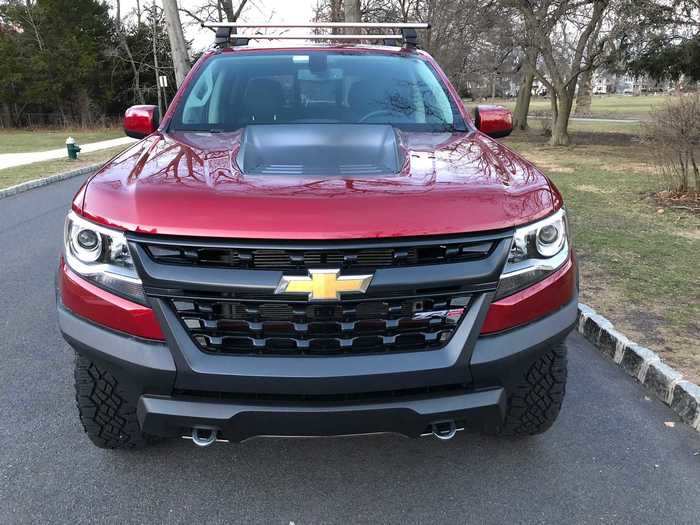
Our test truck was $43,475. The Colorado ZR2 is already a lot pricier then the $20,000 basic Colorado, but our tester came well-optioned out of the box, before a few extras added about $700.

Our ZR2 came with a crew cab and a "short box" bed. Some folks don't much like short boxes, but I think for the uses that most owners would put the Colorado to, the short box is ideal.
The Chevy Colorado brought General Motors back to the small-pickup game. I sampled the base truck in 2014, and in 2018 I checked out the ZR2 upgrade — in "Cajun Red Tintcoat." What a great color! I want all my cars to look like this.

Ford needed to get back in the smaller pickup market in the US, and restoring the Ranger nameplate was an obvious move. It's exactly what you'd expect for Ford, the pickup king: an excellent truck.
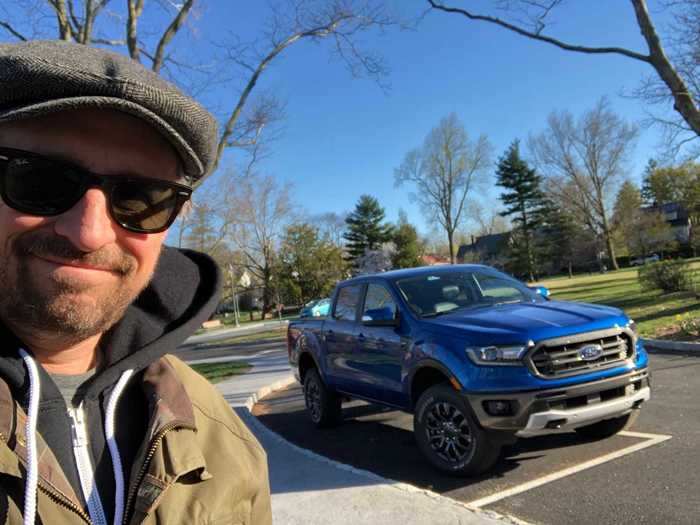
"The Ranger handled everything and was easy to drive on top of it," I wrote in my review.
"Sure, it bounced me around on uneven Manhattan streets, but everywhere else, the truck was smooth. The steering was carlike, and the engine pumped power smoothly through the 10-speed without a sense that the Ranger was eager to get to the overdrive gears to boost its mpg."
And I added: "As equipped, my 2019 Ranger tester was a tad pricey, but it lacked nothing. The interior was lovely, the infotainment was first-rate, the design was snappy, and other reviewers who've had a chance to go off-road have been impressed. (I didn't get to go all down-and-dirty with the FX4 setup, which is extensive and even offers offroad cruise control.)"
Ford's Sync 3 infotainment system runs on an 8-inch touchscreen. Sync 3 is one of the best in the industry. It provides superb navigation, easy Bluetooth connectivity, and AUX and USB device-connection options. Sync 3 also offers a suite of apps and has both Apple CarPlay and Android Auto available.
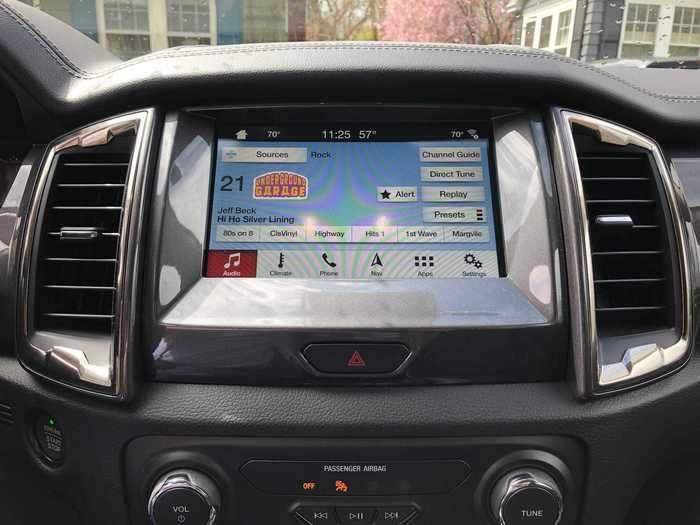
The rear bench seat is snug. Overall, the Ranger's interior space and appointments were on par with the well-equipped Chevy Colorado. The Ranger was also much nicer than the Toyota Tacoma.
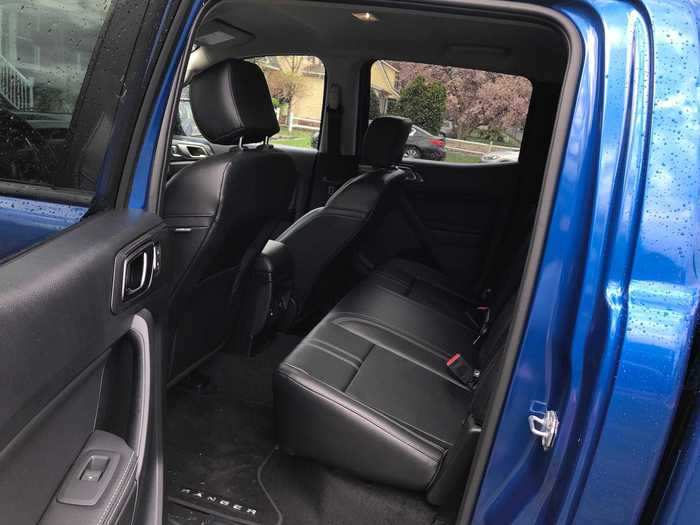
The interior of our tester was a no-nonsense "ebony," but the upholstery was leather. The front seats are heated.
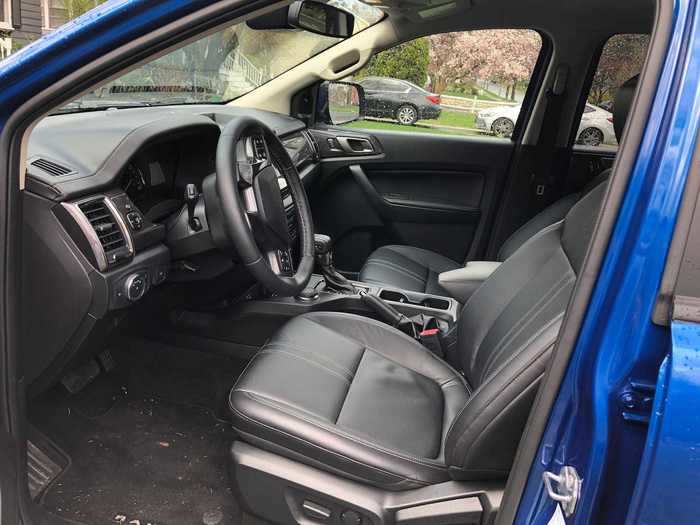
The 2.3-liter EcoBoost four-cylinder engine is a turbocharged powerplant that cranks out 275 horsepower and 310 pound-feet of torque. A 10-speed transmission handles the shifting duties. Towing capacity is 7,500 pounds — enough to tow just about anything owners of the Ranger would want to.
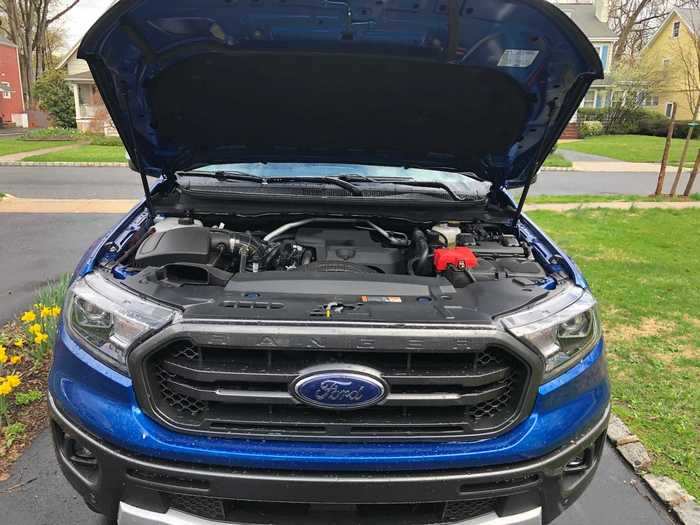
I used the Ranger for both a Costco run and to haul some furniture. This is where midsize pickups really show their versatility.
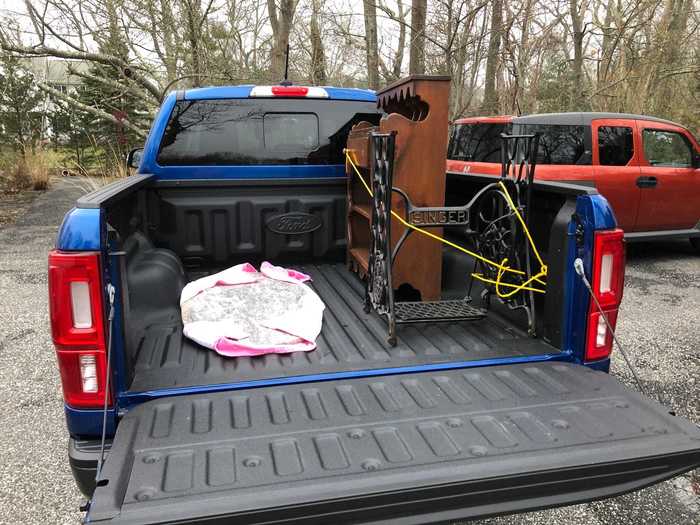
But the Ranger also enjoys Ford's EcoBoost engine tech, which uses turbocharging to retain power with good fuel-economy. In this case, the truck gets 20 mpg city, 24 highway, and 22 combined.
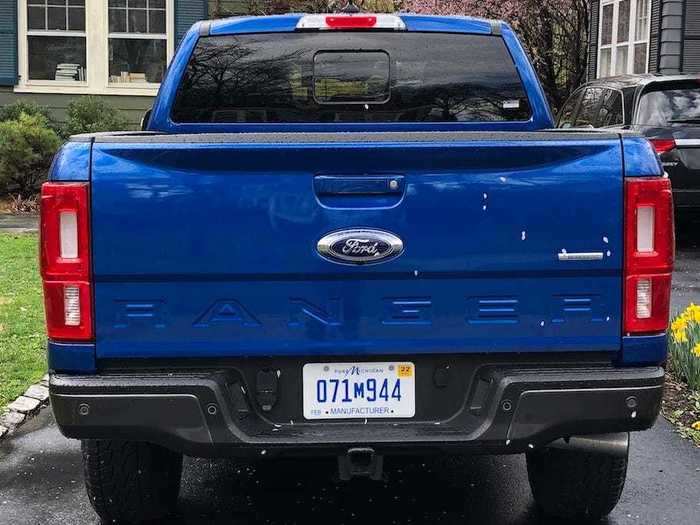
The Ranger boasts a solid four-wheel-drive system — FX4 — with a locking differential. The package adds another grand or so. Our tester came with stout off-road rubber.
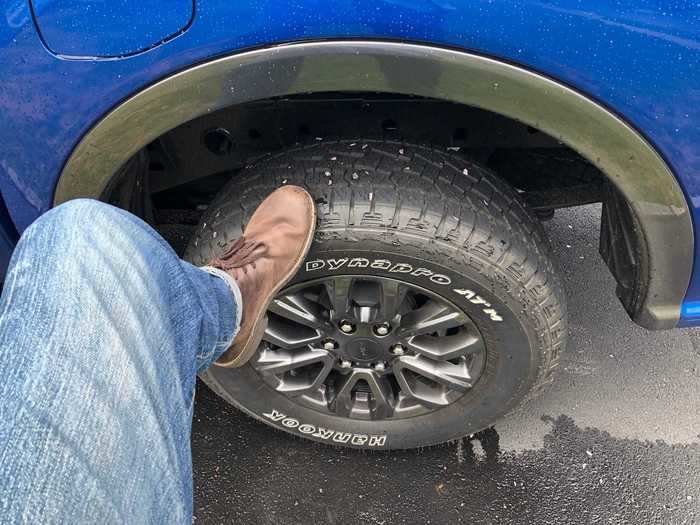
The Ranger is a handsome pickup, especially in "Lightning Blue." The Blue Oval and the Ranger nameplate share space on the blacked-out grille.
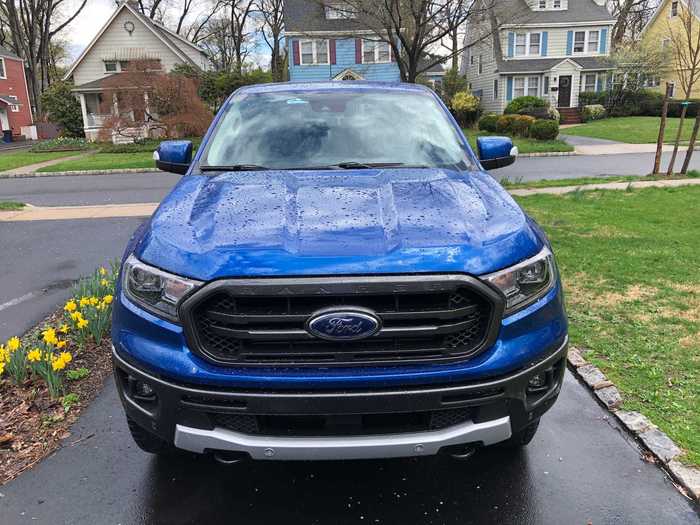
The SuperCrew configuration sports a five-foot bed, but the Ranger can be had with a two-door cab and a six-foot bed. The Lariat series packaging adds about $2,000 to the price tag.

The Ford Ranger returned to the US market in 2019. My Lariat SuperCrew four-wheel-drive Ranger was nicely equipped and stickered at almost $45,000. The base-price pickup is a little more than $24,000.

READ MORE ARTICLES ON
Popular Right Now
Popular Keywords
Advertisement
